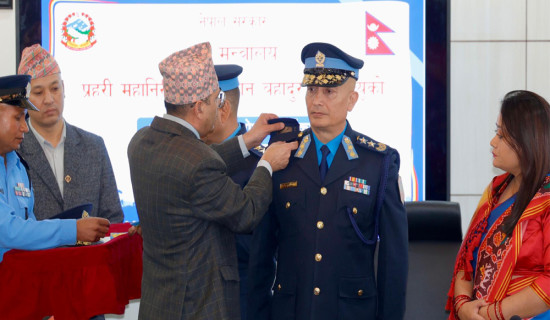- Thursday, 13 November 2025
E-governance Crucial To Realise Constitutional Ideals
The Constitution-2015 of Nepal provides a solid legal foundation for the implementation of its provisions on rights to information, privacy, equality, and the principles of state policy and affairs. It also encourages transparency, efficiency, and inclusivity in governance. And robust e-governance offers the best hope to realise these goals.
Nepal has been making significant strides in e-governance. As the digitalisation of services takes hold at local, provincial, and federal levels, all Nepalis across the social spectrum are enjoying increasingly faster, economical, and effective services. Online services, from applying for driving licenses and citizenship certificates to making property-related transactions, are cases in point. Some provincial hospitals have even launched an online system allowing patients to register, make appointments to see the doctor of their choice, and avail themselves of other services.
The Digital Nepal Framework, launched in 2019, has been the long-term strategic plan to guide the country’s digital transformation, including e-governance. It aims to enhance public services and promote the digital economy. As the government is determined to improve and expand such services in its effort to catch up with the pace of digitalisation, they are sure to get even better in scope and reach.
Citizen centric
As services become accessible through online platforms, the need to physically visit government offices, wait in long lines, or even shell out money to middlemen has been obviated. This has not only enabled easier access to services but also streamlined bureaucratic processes and saved a great deal of time and effort. The rollout of the National Identity Card (NID), a biometric-based system hailed as a unified digital identification system, has been a major development.
What’s more, with the Inland Revenue Department implementing an online tax filing system, paying taxes and filing returns have become a lot easier. The launch of a mobile app named “Nagarik App” has perhaps been the biggest step towards realising the goal of developing the nation into a hub of information and communication technology (ICT). Launched to centralise government services, the citizen-centric app reflects progress in providing access to government documents and services digitally.
ICT tools such as apps, social media platforms, and online forums have enabled the three-tier governments to engage with citizens, collect feedback, and incorporate them into the decision-making process, ramping up people’s participation in governance. Not only has this given voice to the voiceless, but it has also empowered them to have their say in the decisions the government makes.
Adoption of cloud computing is another milestone. When government agencies operate their systems through their own infrastructure, the cost of human resource management and infrastructure goes up, so the concept of creating a shared infrastructure of the government cloud has been introduced for maximum use at the minimum cost. The necessary resources (CPU, RAM, Storage, Public IP, among others) are provided to the government agencies to host and operate websites and web applications, backup important data, and operate ICT-related systems.
Through cloud computing, resources are provided as free virtual computer equipment from a common platform arranged by linking servers, storage, network devices, security devices, and other computer equipment. This effort has paid off handsomely: government machinery has become more transparent, leaving little or no room for corruption to rear its ugly head.
The recently made public national budget has announced the nation’s goal of exporting ICT services worth thousands of billion rupees in the next fiscal, alongside the creation of 500,000 direct employment opportunities and one million indirect jobs in the sector. It has also announced to establish ICT as an instrument for economic growth, enable a legal foundation for exploring and promoting ICT innovation, and promote the development of AI with the regulating provision in place. This is a testament to how much importance ICT has been given by successive governments.
That e-governance is transforming the way governments operate and interact with citizens is clear for all to see. Over the past decade, the government has introduced several digital initiatives, but the implementation and adoption of e-governance haven’t been without challenges. Nepal still struggles with inadequate digital infrastructure, especially in rural areas. Limited internet access and low digital literacy stand in the way of its adoption.
Continued improvement in infrastructure, digital literacy programmes and the integration of various government services will be crucial for the success of e-governance in the country. Overall, Nepal’s e-governance is evolving, with promising initiatives, but it requires sustained efforts to overcome challenges like infrastructure gaps, coordination issues, and digital literacy barriers.
Artificial intelligence
The defining nature of technology is that it keeps on upgrading. This means that the newer updated version of the technology currently in use has already been on the cards and rolled out. As such, constantly keeping abreast with the latest development ensures we’ll not miss out on the best version. Artificial intelligence (AI) has taken the world by storm, bringing sweeping changes and promising even more.
To stay relevant and avoid the risk of falling behind, adoption of AI-powered tools and integrating them into government services is imperative. One such sector is weather forecasting. Nepal is highly prone to natural hazards, with floods, landslides, wildfires, and others claiming hundreds of lives and inflicting catastrophic damages every year. Many countries, including India, are making use of AI to build climate models to improve weather forecasting as extreme climatic events—like heat waves and flash droughts—increase in frequency and intensity.
AI is so appealing because it has already outperformed conventional forecasting models in precision and cost, meaning that it can generate higher-quality data at reduced cost, obviating the need for costly supercomputers presently in use. Needless to say, accurately predicting natural disasters saves a great deal of lives and properties, for it alerts security agencies early so that they have ample time to rescue the vulnerable people to safety.
(Basyal works as a journalist at The Rising Nepal)



-original-thumb.jpg)




-(1)-square-thumb.jpg)





-original-thumb.jpg)

